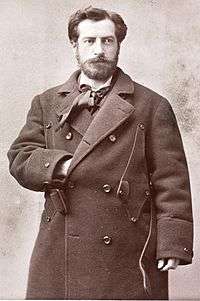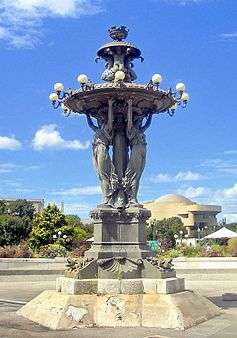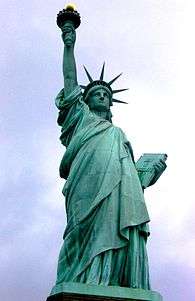Frédéric Auguste Bartholdi





Frédéric Auguste Bartholdi (French: [fʁedeʁik oɡyst baʁtɔldi]; 2 August 1834 – 4 October 1904) was a French sculptor who is best known for designing the Statue of Liberty.
Life and career
Born in Colmar, in the Haut-Rhin department of France, to Jean Charles Bartholdi (1791–1836) and Augusta Charlotte Bartholdi (née Beysser; 1801–1891), Frédéric Auguste Bartholdi was the youngest of their four children, and one of only two to survive infancy, along with the oldest brother, Jean-Charles, who became a lawyer and editor. When Bartholdi's father died, his mother moved the family to Paris, while still maintaining ownership and visiting their house in Alsace, which later became the Bartholdi Museum. He attended the Lycee Louis-le-Grand in Paris, and received a BA in 1852. He then went on to study architecture at the École nationale supérieure des Beaux-Arts as well as painting under Ary Scheffer in his studio in the Rue Chaptal, now the Musée de la Vie Romantique. Later, Bartholdi turned his attention to sculpture, which afterward exclusively occupied him.
Bartholdi served in the Franco-Prussian War of 1870 as a squadron leader of the National Guard, and as a liaison officer to General Giuseppe Garibaldi, representing the French government and the Army of the Vosges. In 1875, he joined the Freemasons Lodge Alsace-Lorraine in Paris. In 1871, he made his first trip to the United States, to select the site for the Statue of Liberty, the creation of which would occupy him after 1875.
On December 15, 1875, Bartholdi married Jeanne-Emilie Baheux Puysieux in Newport, Rhode Island. They had no children.
Bartholdi was one of the French commissioners in 1876 to the Philadelphia Centennial Exposition. There he exhibited bronze statues of "The Young Vine-Grower", "Génie Funèbre", "Peace" and "Genius in the Grasp of Misery", for which he received a bronze medal.
Bartholdi, who received the rank of Commander of the Legion of Honor in 1886, died of tuberculosis in Paris on 4 October 1904.
The Statue of Liberty
The work for which Bartholdi is most famous is Liberty Enlightening the World, better known as the Statue of Liberty.
Soon after the establishment of the French Third Republic, the project of building some suitable memorial to show the fraternal feeling existing between the republics of the United States and France was suggested, and in 1874 the Union Franco-Americaine (Franco-American Union) was established by Edouard de Laboulaye. Bartholdi's hometown in Alsace, having first lost independence and passing under French control, had just passed into German control in the Franco-Prussian War. These troubles in his ancestral home of Alsace are purported to have further influenced Bartholdi's own great interest in independence, liberty, and self-determination. Bartholdi subsequently joined this group, among whose members were Laboulaye, Paul de Rémusat, William Waddington, Henri Martin, Ferdinand Marie de Lesseps, Jean-Baptiste Donatien de Vimeur, comte de Rochambeau, Oscar Gilbert Lafayette, François Charles Lorraine, and Louis François Lorraine. The plan of Bartholdi having been approved, the Union Franco-Americaine raised more than 1 million francs throughout France for the building of the statue. In 1879, Bartholdi was awarded design patent U.S. Patent D11,023 for the Statue of Liberty. This patent covered the sale of small copies of the statue. Proceeds from the sale of the statues helped raise modest but insufficient money to build the full statue. While funding for the statue continued to be a problem for years, the idea was compelling enough to survive, and finally funding was completed in some large blocs from within the Union Franco-Americane and their organized efforts with other connections. On 4 July 1880, the statue was formally delivered to the American minister in Paris, the event being celebrated by a great banquet.
Before starting his commission, Bartholdi had traveled to the United States and personally selected Bedloe's Island in New York Harbor as the site for the statue. The United States agreed to responsibility for funding the building of the pedestal, with about $300,000 being raised. In October 1886, the structure was officially presented both to the nation and to all aspirers to liberty within the world, as the joint gift of the French and American people.
The statue is 151 feet and 1 inch high, and the top of the torch is at an elevation of 305 feet 1 inch from mean low-water mark.[1] It was the largest work of its kind that had ever been completed up to that time, but was the tallest structure in New York City for only four years, until the New York World Building surpassed it at 349 feet in 1890.
It was rumored in France that the face of the Statue of Liberty was modeled after Bartholdi's mother.[2] In Paris on the Ile aux Cygnes, there is a replica of the Statue of Liberty which faces west supposedly in alignment with the Statue of Liberty in New York.
Works in Colmar
Bartholdi's hometown Colmar (modern political administrative region of Alsace-Champagne-Ardenne-Lorraine) has a number of statues and monuments by the sculptor, as well as a museum founded in 1922 in the house in which he was born, at 30 Rue des Marchands.
- Monument du Général Rapp – 1856 (first shown 1855 in Paris. Bartholdi's earliest major work)
- Fontaine Schongauer – 1863 (in front of the Unterlinden Museum)
- Fontaine de l'Amiral Bruat – 1864
- Fontaine Roeselmann – 1888
- Monument Hirn – 1894
- Fontaine Schwendi, depicting Lazarus von Schwendi – 1898
- Statue "Les grands soutiens du monde" − 1902 (in the courtyard of the museum)
Other major works
Bartholdi's other major works include a variety of statues at Clermont-Ferrand, in Paris, and in other places. Notable works include the following:
- 1852 : Francesca da Rimini;
- 1870 : LeVigneron;
- 1876 (plaster version in 1874) : Frieze and four angelic trumpeters on the tower of Brattle Square Church, Boston, Massachusetts, United States;
- 1876 (executed 1872, cast 1873[3]) : The Marquis de Lafayette Statue, in Union Square, New York City, United States;
- 1878 : The Bartholdi Fountain in Bartholdi Park, the United States Botanic Garden, Washington, D.C., United States;
- 1880 : The Lion of Belfort, in Belfort, France, a massive sculpture of a lion carved into the side of a mountain, depicting the huge struggle of the French to hold off the Prussian assault at the end of the Franco-Prussian War. Bartholdi was an officer himself during this period, attached to Garibaldi.
- 1889 : Switzerland Succoring Strasbourg, at Basel, Switzerland, which was a gift from the French city of Strasbourg, in appreciation of the humanitarian help it had received during the Franco-Prussian War.
- 1892 : Fontaine Bartholdi, on the Place des Terreaux, in Lyon, France.
- 1895 : Lafayette and Washington Monument, in the Place des États-Unis, Paris, and an exact replica at Morningside Park, New York City, United States.
- 1903 : Equestrian statue of Vercingetorix in Place de Jaude, Clermont-Ferrand.
See also
References
Notes
- ↑ "Statue of Liberty: Frequently Asked Questions", National Park Service website
- ↑ "Frequently Asked Questions About the Statue of Liberty" on the United States National Park Service's Statue of Liberty website
- ↑ "Union Square Highlights" on the New York City Parks Department website
Sources
-
 Wilson, James Grant; Fiske, John, eds. (1900). "Bartholdi, Frederic Auguste". Appletons' Cyclopædia of American Biography. New York: D. Appleton.
Wilson, James Grant; Fiske, John, eds. (1900). "Bartholdi, Frederic Auguste". Appletons' Cyclopædia of American Biography. New York: D. Appleton.
Further reading
- Belot, Robert; Daniel Bermond (2004). Bartholdi.
- Durante, Dianne (2007). Outdoor Monuments of Manhattan: A Historical Guide. New York University Press.
- Gschaedler, Andre (1966). True Light on the Statue of Liberty and Her Creator.
- Moreno, Barry (2000). The Statue of Liberty Encyclopedia. New York: Simon & Schuster. ISBN 0-684-86227-1.
External links
| Wikimedia Commons has media related to Frédéric Auguste Bartholdi. |
- Biography
- The Bartholdi Fountain and Bartholdi Park – Washington, DC
- The Bartholdi museum (French)
- The Statue of Liberty enlightning the world, described by the sculptor Frédéric Bartholdy
- Works by or about Frédéric Auguste Bartholdi at Internet Archive
- Works by Frédéric Auguste Bartholdi at LibriVox (public domain audiobooks)

- Frédéric Auguste Bartholdi in American public collections on the French Sculpture Census website
|
